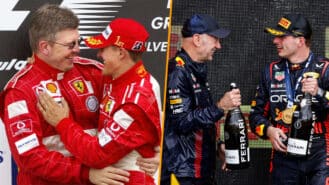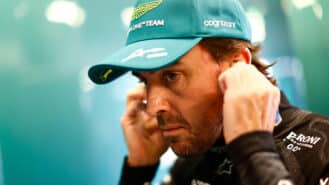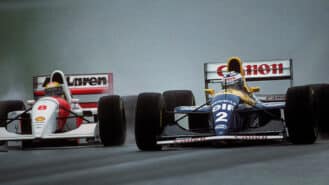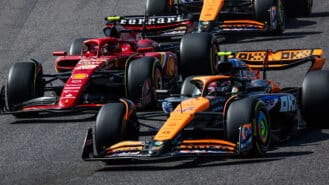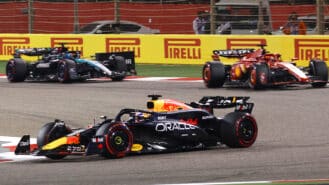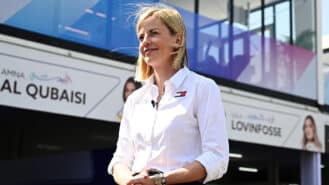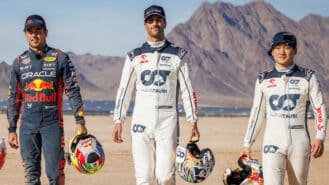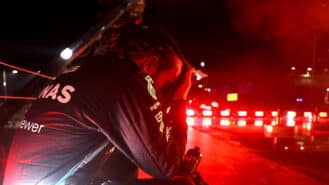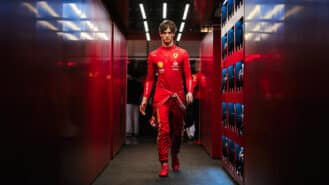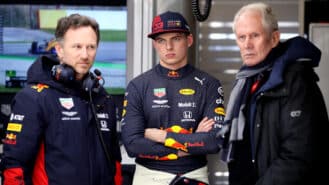The transformation of Aston Martin continues apace, with the announcement that from 2026 it partners up with Honda as the Japanese company has officially U-turned on its 2021 decision to leave Formula 1.
They have found each other at the perfect time. It moves Aston into the big league with its own automotive power unit partner just as it has established its very real credentials as a team capable of fighting at the front. This year’s car is probably only second to Red Bull despite its current customer team status. But a customer team probably isn’t ever going to win the world championship. Team owner Lawrence Stroll is doing all the right things to make his vision of world championships real, the investment, the recruitment and now this.
For Honda it’s a great rescue from inadvertently losing its partnership with F1’s top team, Red Bull. That has been a complicated saga arising from the almost skunk works status of Honda Racing Corporation within Honda the parent company. HRC is highly autonomous, an aggressively creative entity and it was almost as if it simply refused to acknowledge Honda’s withdrawal from F1, announced early in 2021. It kept going with the existing power unit project, helping Red Bull out of a hole, and the Honda badge was even back on the cars by the latter part of last season. HRC simply engineered itself an F1 continuation deal for the balance of these PU regulations, running to the end of ’25. Red Bull and HRC together tried for a time to convince the Honda parent company to recommit to the new regulations of ’26, based on the increased electrical power and sustainable fuels. But that didn’t get around the expense issue. Honda had invested enormous sums in returning to the top of F1 – and it simply wasn’t up for doing that all over again. Hence Red Bull moved on for ’26, using its Red Bull Powertrains facility to partner up with Ford.
But still HRC pressed on – and in the person of Lawrence Stroll it has effectively found a way of battering down the parent company’s final objection to F1: the cost. This deal effectively sees the team commissioning Honda to create a power unit, in much the same way that McLaren once commissioned Porsche to create the TAG turbo. The cost is being borne by Aston, not Honda. So with both the green credentials and the cost boxes ticked, corporate Honda now has no reason not to align itself once more with the racers at HRC and everyone is happy.
Aston CEO Martin Whitmarsh explained the real significance of what this deal means to the team: “Mercedes have been great partners for the team – and they remain that. They’re in it to win. And clearly, we’re here to win as well. So ultimately, there is some incompatibility in those two missions. That’s why we’ve taken the decision.
“The question arises of who will be driving the Aston-Honda of 2026”
“I think the first and obvious example was, we currently share a wind tunnel with them. And yet, we’re having to spend a huge amount of money to build our own wind tunnel, which is only four or five miles from the quite adequate one that we use.
“But the nature of F1 is if you want to win. It means beating Mercedes and it’s extremely difficult to beat an organisation as good as Mercedes if you’re reliant on them for intellectual property, facilities, components.
“Team Silverstone has got a great tradition of delivering big bang for small bucks. But we’re in a different position now, the Aston Martin brand, the ambition of Lawrence Stroll, and now great partners like Honda, we are here to win. Therefore, you’ve got to have the complete integration of facilities and process and approach.”
The models of each of the ‘works’ teams are now very diverse. Audi as a corporate entity will make its own power unit and has effectively bought its own team (Sauber). Mercedes owns one-third of its race team but all of its power unit factory at Brixworth. Red Bull has its own Powertrains programme which will effectively be ‘sponsored’ by Ford from ’26 and now Aston will pay Honda for its services.
Whichever way it’s structured by each team, the 2026 PU regulations seem to have been successful in enhancing automotive participation in F1, but without the grid being dominated by full-on factory-owned entities and therefore over-vulnerable.
As Aston continues to put all the pieces in place to be in full control of its own destiny, the question arises of who will be driving the Aston-Honda of 2026. We can assume Lance Stroll will be one. Fernando Alonso? He’ll be 44 by then, turning 45 in the July of that year, a year younger than Juan Manuel Fangio when he won his final world title in 1957. How long can Fernando continue to operate at this level? “I don’t know what I will be doing in 2026,” he said in Monaco. “I’m still motivated and still fast but I know one day I will wake up and maybe not be motivated, or not fast – when I would be the first to raise my hand and admit it.”
But Aston team principal Mike Krack can see “absolutely no reason” why Alonso won’t still be still there in ’26, fully motivated and super-fast. But it would be surprising if the emergence of a powerful new top team does not see many drivers sniffing around with great interest. This new deal has changed the power dynamics within F1.
Since he began covering grand prix racing in 2000, Mark Hughes has forged a reputation as the finest Formula 1 analyst of his generation
Follow Mark on Twitter @SportmphMark
